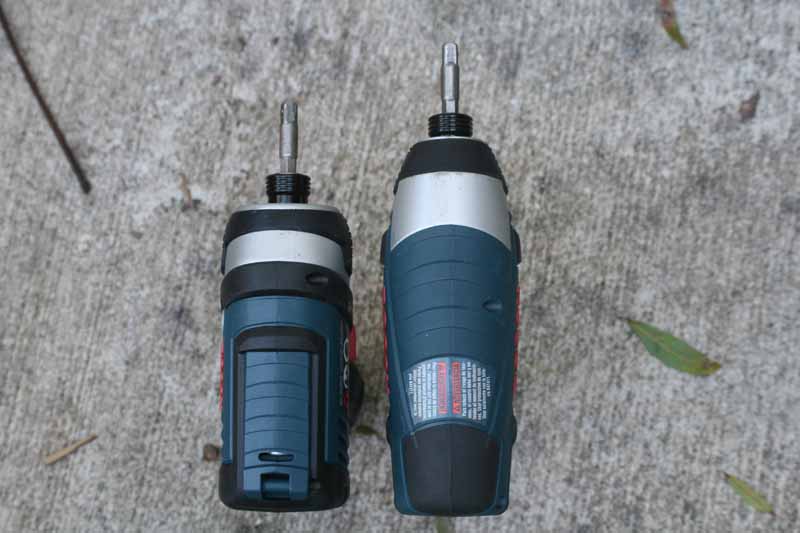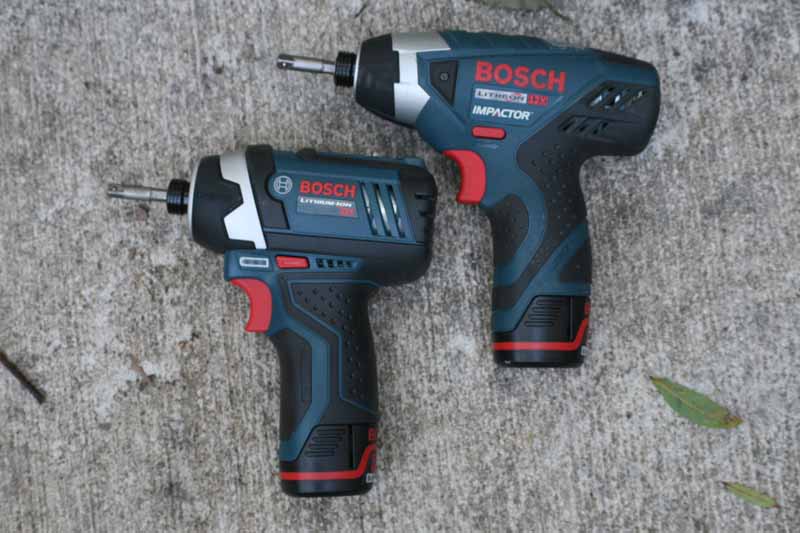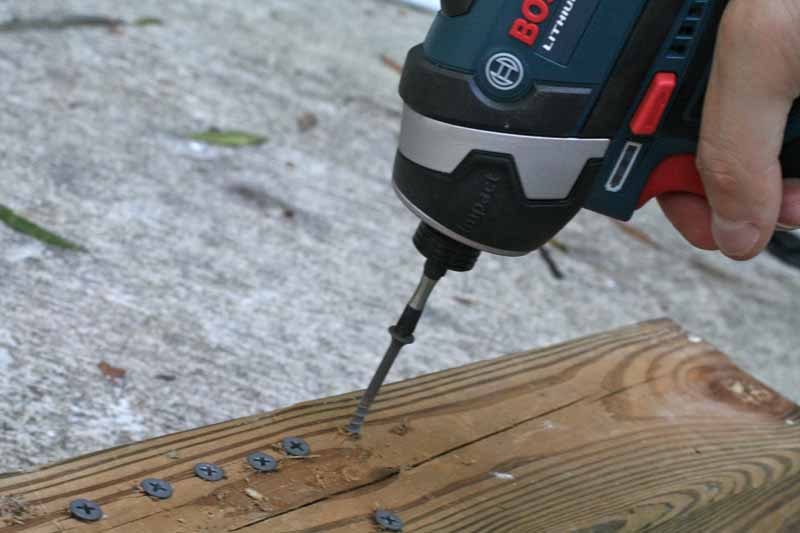The first generation of Bosch’s 12V line of tools was impressive, but the fact that just about three years later they released a third-generation impact driver means that they are coming after the market with a vengeance. The case in point would be the brand new Bosch PS41-2A Impact Driver. For this review, I was able to borrow the second-gen PS40-2A Impactor from a friend and therefore face off the newer model against its predecessor. The results definitely proved that the new impact driver didn’t just get smaller, it got more powerful.
Upgrading the PS40-2A
Bosch seemed to attend to two different aspects of tool improvement at the same time. They made the Bosch PS41-2A Impact Driver smaller than the PS40-2A and, at the same time, making it much more powerful. The list of improvements is significant. You get a reduced footprint and an on-tool LED battery indicator. Bosch also delivered over 14% more torque. They even improved the rubberized grip for better handling.
When we say “improvements” we really are understating the truth of the matter. The Bosch PS41-2A Impact Driver is like a whole new tool. When you shave off over an inch from the front of the tool and add the kind of features Bosch did, what you’re really talking about is an entirely new beast. When I brought it next door to show my neighbor, a professional trim carpenter and cabinet maker, he commented that Bosch had almost crossed this tool over into the realm of right angle drill – so low was its depth profile. We’d have to agree.
Bosch PS41-2A Impact Driver Battery Upgrades
The battery for the PS41-2A Impact Driver has gone from model BAT411 to BAT412. Based on our testing and results, this is a beneficial advantage as the BAT412 offers significantly more consistent run-time and longer life. The Bosch Impact Driver seems to also use the entire shaft of the tool, all the way up to the hex chuck as a heat sink.
It heats up a good amount during extended use, but it also draws that heat from the motor, extending its life and reducing wear and tear. This continues to be an excellent design.
PS41-2A vs PS40-2A Impact Driver
How do the specifications of the PS41-2A stack up, in terms of its improvements, to the older PS40-2A Impactor? Here’s a quick comparison of both tools:
| PS41-2A Impact Driver | PS40-2A Impactor | |
|---|---|---|
| Torque | 930 in.-lbs. | 800 in.-lbs. |
| RPM | 0-2600 | 0-1800 |
| BPM | 3100 | 3000 |
| Weight | 2.1 lbs. | 2.2 lbs. |
| Battery Level Indicator | Yes | No |
| LED light | 2nd Gen | 1st Gen |
| Battery | BAT412 | BAT411 |
Bosch PS41-2A Out of the Box
Like Bosch’s other 12V Lithium-ion tools (the tool drops the “Litheon” name as well as “Impactor” from this model), the PS41-2A arrived in the same zippered case that we love to hate. They actually upgraded the zippers, if you can believe that and they are much easier to grab, being slightly curved to the ergonomics of your fingers. The short depth of the PS41-2A means that you can easily store it in the case with a standard bit attached. The complete PS41-2A kit includes the Pocket Driver, two BAT412 lithium-ion batteries, and a BC430 30-minute charger.
Bosch PS41 Impact Driver Durability
Bosch continues to use well, it’s black rubber overmold to both protect the tool as well as provide ample grip positions and prevent hands from slipping on the tool. We immediately noted that they had added a bit more to the trigger side of the handle, enabling it to be gripped even more securely in the hand compared to last year’s model.
Where the PS40-2A has screws located in the center of the protective side bumpers that were susceptible to abrasion, Bosch has now either recessed or completely covered these in the PS41-2A. The LED light is still located on the front of the tool, surrounding the hex bit, however it is a larger displacement now due to the new shape of the front of the tool. The diffusion they selected is odd (having dramatic “hot spots”), but it does indeed light the work area during use, so it’s certainly effective and fulfills its intent.
Frameless Motor
Bosch’s PS41-2A 12V Max Impact Driver uses a new high-performance frameless motor that is slightly wider, but dramatically less long than their first-generation 12V tools. The result is a stockier head that sits well-balanced on the handle. Bosch also included the new LED battery indicator on the PS41-2A which we also liked on the PS31-2A 3/8″ Drill Driver we reviewed earlier. This is an excellent feature and you no longer have to guess about how much charge is left on your battery when you pick up the tool. It’s shown in beautiful green lights.
PS41 Testing and Use
Lag bolts. We love to hate them, but ever since the invention of the cordless Impact Driver, they haven’t been quite the hassle they used to be. For our testing we drove in a series of 1/4″ x 3″ lag bolts, averaging the time it took to drive them into a pressure treated 4×4 and pull them back out again. For comparison, we pitted the new PS41-2A against its father, the PS40-2A. To keep it fair, both tools made use of a brand new, fully-charged BAT412 battery.
We found that the PS41-2A could drive a bolt in at an average time of 18 seconds, a full 6 seconds faster than the PS40-2A. That gave the PS41-2A an increase of 33% over the former model. Pulling out the bolts was even a bigger difference, with the PS41-2A doing it in just 6 seconds and the older PS40-2A repeating the task in 18 seconds. Apparently that additional 130 in.-lbs. of torque goes a long way.
Driving Drywall Screws
We next drove ten 3″ course thread drywall screws into the same 4×4 and timed how long it took the two tools. This was a real head-to-head competition and we were pleased to see that while the PS41-2A won, it didn’t make the PS40-2A look like a slouch in the process like it did in the lag bolt testing. The PS41-2A completed the task in 1:01 while the PS40-2A took an additional 16 seconds to get all ten nails in. If you account for the variance in time to ready the screws the margin of error means that for lighter loads these tools are nearly identical, but for heavier duty work the new PS41-2A really does seem to make a difference.
Sound output by the Bosch PS41-2A reached only 78 dB SPL at our customary 36-inch distance from the business end of the tool, however when it began impacting you can expect it to ramp up to around 95dB SPL. The noise varied depending upon what exactly we were driving and into what kind of material we were doing it.
We measured the speed on the Bosch PS21-2A with our laser tachometer and found it to be 2670 RPM, actually 3% over the rated speed of the tool (with no load). Just for fun we decided to test the tool again after using it on a variety of jobs that drained the battery to 2 bars. We measured the speed and still found it to be around 2350 RPM, 90% of its rated speed. We have always found Bosch to have fairly accurate and truthful specs, and this tool continues that trend.
Conclusion
I never recommend that anyone buy just one tool. However, if I had to recommend one personal-use drill/driver for the home, this would be it. The PS41-2A is an incredible tool that fulfills a myriad of uses. Its flexible hex drive allows it to be used quickly and easily with the latest drill and driver bits, and its excellent torque rating makes it worthy of all but the toughest jobs.
This is one tool that we think consumers will get a lot of use out of, and its diminutive size means that both consumers and professionals will find it extremely handy to use in cramped quarters where space is at a premium. For sheer performance, we think this tool presently beats nearly all others in its class. It also delivers on Value. At just $89.99 for the bare tool, we find it easy to recommend.











